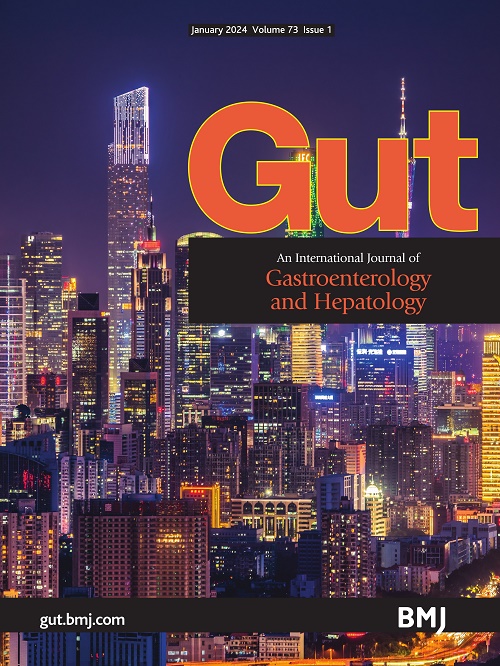New player in inflammation-driver liver carcinogenesis: pirin on fire!
IF 25.8
1区 医学
Q1 GASTROENTEROLOGY & HEPATOLOGY
引用次数: 0
Abstract
Pirin (PIR) is a 32 kDa iron-binding protein belonging to the cupin superfamily, with well-recognised roles that include functioning as a transcriptional co-regulator.1 A single ferrous ion (Fe²+) is housed within the N-terminal domain, where it serves as a redox-sensitive allosteric site.2 This iron-binding region is critical for modulating PIR’s conformational dynamics and subcellular localisation in response to fluctuations in the intracellular redox state.3 Under oxidative conditions, PIR undergoes a redox-dependent transition from its reduced Fe²+ (inactive) to oxidized Fe³+ (active) form.3 This conformational change enhances its binding affinity for multiple transcription factors, including nuclear factor I (NF-I), B-cell lymphoma 3-encoded protein and the nuclear factor kappa-light-chain-enhancer of activated B cells (NF-κB) subunits p50 and p65/v-rel avian reticuloendotheliosis viral oncogene homolog A (RELA) amplifying the expression of downstream genes.4 Through these molecular interactions, PIR acts as a key modulator within signaling pathways that regulate inflammation, apoptosis and innate immune responses. The role of PIR has been previously described in several solid tumors, including breast,5 lung,6 colorectal cancers7 and melanoma,8 where PIR has been implicated in promoting cell proliferation and inflammatory signaling. However, until recently, few data were available about the role of PIR in the pathogenesis of hepatocellular carcinoma (HCC). In Gut , Ma et al 9 provide convincing evidence that PIR plays a pivotal role in linking oxidative stress, chronic inflammation and HCC progression (figure 1). The authors demonstrated that PIR expression is progressively upregulated from metabolic dysfunction-associated steatotic liver disease (MASLD), viral hepatitis and cirrhosis to HCC, a pattern confirmed across independent datasets both at the transcriptome and protein levels. Functionally, PIR …炎症驱动肝癌发生的新参与者:匹林着火了!
Pirin (PIR)是一种32 kDa的铁结合蛋白,属于杯蛋白超家族,具有公认的作用,包括作为转录共调节因子的功能单个铁离子(Fe²+)被安置在n端结构域内,在那里它作为一个氧化还原敏感的变构位点这个铁结合区对调节PIR的构象动力学和亚细胞定位至关重要,以响应细胞内氧化还原状态的波动在氧化条件下,PIR经历了一个氧化还原依赖的转变,从其还原的Fe²+(非活性)到氧化的Fe³+(活性)形式这种构象变化增强了其与多种转录因子的结合亲和力,包括核因子I (NF-I)、B细胞淋巴瘤3编码蛋白和活化B细胞的核因子kappa-轻链增强子(NF-κB)亚基p50和p65/v-rel禽网状内皮增生病毒癌基因同源物A (RELA),可扩增下游基因的表达通过这些分子相互作用,PIR在调节炎症、细胞凋亡和先天免疫反应的信号通路中起关键调节作用。PIR在多种实体肿瘤中的作用已被报道,包括乳腺癌、肺癌、结直肠癌和黑色素瘤,其中PIR与促进细胞增殖和炎症信号传导有关。然而,直到最近,关于PIR在肝细胞癌(HCC)发病机制中的作用的数据很少。在Gut中,Ma等人9提供了令人信服的证据,证明PIR在氧化应激、慢性炎症和HCC进展之间起着关键作用(图1)。作者证明,从代谢功能障碍相关的脂肪变性肝病(MASLD)、病毒性肝炎和肝硬化到HCC, PIR表达逐渐上调,这一模式在转录组和蛋白质水平的独立数据集中得到了证实。功能上,PIR…
本文章由计算机程序翻译,如有差异,请以英文原文为准。
求助全文
约1分钟内获得全文
求助全文
来源期刊

Gut
医学-胃肠肝病学
CiteScore
45.70
自引率
2.40%
发文量
284
审稿时长
1.5 months
期刊介绍:
Gut is a renowned international journal specializing in gastroenterology and hepatology, known for its high-quality clinical research covering the alimentary tract, liver, biliary tree, and pancreas. It offers authoritative and current coverage across all aspects of gastroenterology and hepatology, featuring articles on emerging disease mechanisms and innovative diagnostic and therapeutic approaches authored by leading experts.
As the flagship journal of BMJ's gastroenterology portfolio, Gut is accompanied by two companion journals: Frontline Gastroenterology, focusing on education and practice-oriented papers, and BMJ Open Gastroenterology for open access original research.
 求助内容:
求助内容: 应助结果提醒方式:
应助结果提醒方式:


